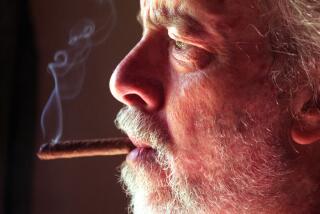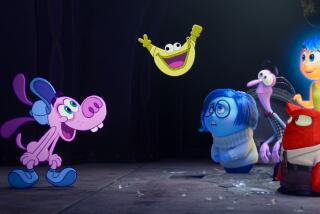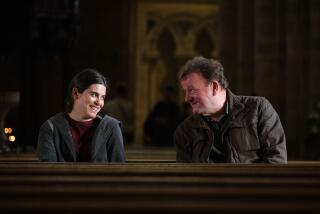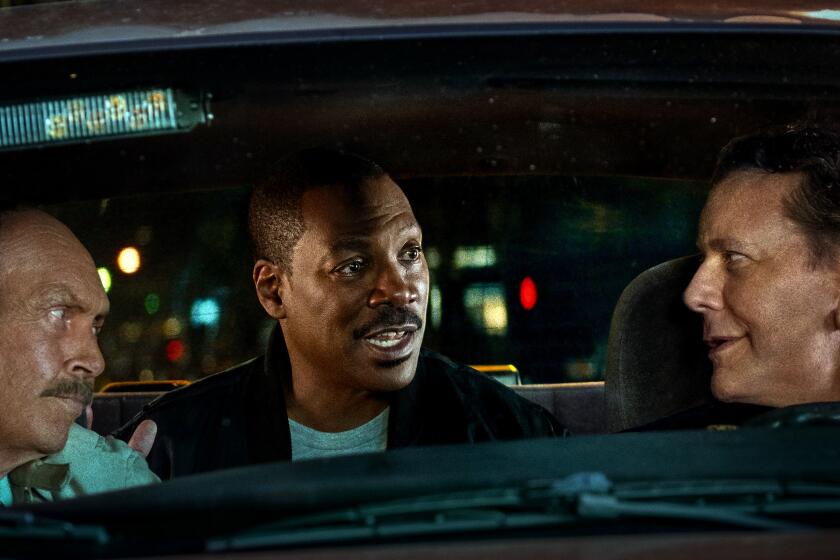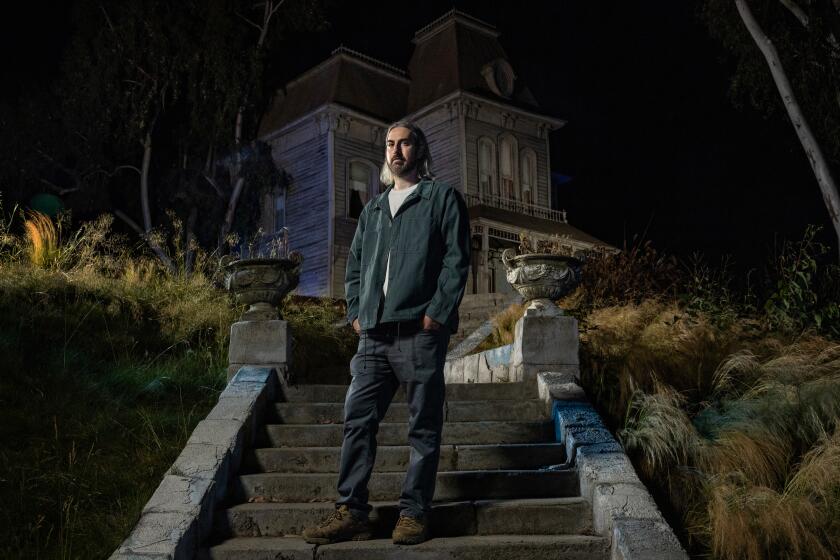A Work in Progress
Most of us have at least one story about laying eyes on someone and immediately falling in love. The ancient Greeks called it “theia mania,” madness from the gods. Vanessa Beecroft’s story of her life with Greg Durkin starts there, with a well-aimed arrow from Eros.
She met her husband one night on a street in Brooklyn. In the dim light she could barely see him. “I got a little bit scared,” she recalls. “This very tall shadow asked me about an apartment. I gave Greg my number and ran inside. The phone rang as soon as I got upstairs.” She was struck. Smitten.
Because Beecroft is a conceptual artist--she’s known for installations using live female figures, sometimes identically dressed, sometimes wearing nothing but Tom Ford high heels--and because her marriage, at times, has had a certain theatricality, it’s a fitting paradox. Love at first sight--revealed in the dark.
Beecroft sits at a long worktable in the minimally furnished living room of her rented home in the Hollywood Hills, wearing leggings and a loose blouse. She is friendly, even peppy, but her energy borders on nervousness. In her lyrical, Italian-inflected English, she apologizes for being indecisive about having this conversation. “It was this subject of love. I got a little bit afraid. My publicist said not to do it--that it’s not my topic.”
But love lies heavy on her mind these days and she may yet warm to talking about it. “This month hit hard,” she says, leaning forward, eyes wide open. “ ‘So, love,’ I said. ‘Why not? This is happening!’ ”
Her willingness reflects the difficult state of her marriage and a need to share the stresses that have recently shaken her relationship. The simplest version of the story, told in a film that screened at the Sundance Film Festival in January, is that Beecroft traveled to Sudan, fell in love with a pair of motherless babies there and labored, in the presence of a documentarian’s camera, to adopt them--without consulting her husband.
The more complicated story, about a couple reeling from the unexpected and struggling to stay upright, is still being written. And it starts with a picture of perfection.
Taped onto the table in front of her are doodles of French cartoon characters, Barbapapa and Barbamama, drawn by her youngest son, Virgil. “This could be me and Greg because they are such a happy family, with very ethical values,” she says, examining one. “Hippies from the ‘70s.”
She circles back to her first meeting with the man who became her husband--it was a few days after she had sent her older Greek artist boyfriend packing, ending their eight-year relationship. Durkin’s presence had registered somehow.
“I hadn’t really even seen him that night,” she says. But when she finally did go out with him, she liked what she saw. “He looked like a Rodin or a Picasso. I thought this would be an interesting person.”
The way to Beecroft’s heart is indeed through her eyes, definitely not her stomach. After studying architecture and painting in the mid-1980s, she entered the Academy of Fine Arts of Brera in Milan, where she focused on set design. She began her exhibition career in art school by displaying “Book of Food” (also known as “Despair”), a journal that catalogs a bulimic’s eating habits--her own--while local girls she hired walked through the space wearing clothes from her wardrobe. This became her medium of choice: live female figures, chosen, she’s said, for their resemblance to her.
Beecroft cemented her reputation by staging dozens of performance-happenings, such as “Show” at the Solomon R. Guggenheim Museum in New York in 1998. For one night, nearly nude models stood for hours in the rotunda while invited guests circulated, watching. The art critics couldn’t decide if she was making a post-feminist statement about fashion or pandering to a corrupted way of seeing.
“My work with the girls has the function of showing issues in a way that is pleasant, but you don’t know what I’m saying,” she explains. “It is destabilizing.”
At the time of her initial encounter with Durkin, he was working at an entertainment-oriented management consulting firm. He recalls that first meeting less mythically than she--”more a friendly neighbor thing.” But it did resonate. “I liked her voice--light and exotic.” Later, on their first date, Durkin says, “We went to dinner and . . . talked for a few hours about world views and our philosophies--where it all began for me. She was really intelligent and inspiring.”
The visual attraction was also in play for him. “I remember she was running on ice in high heels, which was this kind of elegant punk-feminine thing. She was strong and weak at once. She was beautiful.”
He proposed three months later, offering his grandmother’s diamond ring. Beecroft said yes.
Now she giggles girlishly. “He brought me flowers every day. It was a very romantic courtship. Very old-fashioned . . . so I really liked it.”
Still, she’s quick to capsize the image of romance. There’s her own family history to consider, an Italian mother and English father who separated when she was 2, with her mother taking her to a small village in Italy. Beecroft believes it was the influence of her mother, aunt and grandmother--she calls it her matriarchal society--that shaped her relationships with men.
“Men didn’t really count or exist--they were beasts. I was trying to destroy all the men around me as soon as intimacy was established.”
You’d be right in thinking this sounds like a foreign film. “My mother liked watching ‘Scenes From a Marriage,’ ” she says. “I love that movie.” The 1974 Ingmar Bergman film about the tempestuous relationship between Marianne (Liv Ullmann) and Johan (Erland Josephson) isn’t exactly a guide to matrimony--the couple pulls apart, has affairs, reconnects and finally divorces, after which they continue their relationship. As Ullmann’s Marianne says, “We’re pitiful, self-indulgent cowards that can’t connect with reality and are ashamed of ourselves.”
“I would watch it for hours when I was really young,” Beecroft says. “So how could I actually go for a marriage myself?”
The idea of a wedding, though, struck her imagination. “I decided to customize the procedure,” she says with great animation. “I went to Portofino near where my mother lives and found a chapel with a chicken inside and a portrait of St. Sebastian on the wall. My mother collected writings about St. Sebastian and homosexuality--he was hit by the arrow and had ecstasy! So it was a perfect church.”
Beecroft organized the wedding and a photo shoot in the chapel, dressing her husband, lawyer, art dealer and others all in white. She removed the altar and tried to get the priest to join in. He ran away. “Greg got upset because I reduced it to a project,” she says, “but for me it was symbolic. Now it had sense for me. Not because I would make money or make it a work, but I could make it something with meaning since I was raised believing that the church and marriage were stupid.”
Every marriage is a form of shadow play--telling and retelling stories using light, shadow and illusion--often for entertainment, sometimes for survival. In Beecroft’s hands, this narrative is sophisticated. Many scenes--her first meeting with Durkin, their courtship, the wedding--seem chosen to show hope, and pessimism, which were there from the beginning. Her needs and motivations, though, are more obscure.
We skip fairly quickly over the years when she and Durkin were settled in Cold Spring Harbor on Long Island, the suburban enclave where he grew up and that became her base as she mounted shows in Turin, Italy; Paris; Lisbon; and Los Angeles. In the suburbs, she was surprised to discover a strong maternal instinct when her two sons were born. “I got completely absorbed by the children. I didn’t know I was such a mother.”
In May 2005, Beecroft was alone on a plane traveling to Brescia, Italy, for an art show when she read an article about genocide in Sudan that disturbed her greatly. By coincidence, on arriving at her destination, she discovered that the Sudanese bishop of the Roman Catholic Church had just been there on a fundraising mission. She gathered information and joined a church-sponsored trip to southern Sudan six months later.
Beecroft was still nursing her younger son, Virgil, and during the flight to Sudan she developed mastitis, a breast infection, due to the build-up of milk. “When I landed, I offered the bishop mother’s milk for the local children,” she says. “Sister Jacqueline from the order of Teresa Sisters brought me to a dark room with three newborns who had lost their mothers and had not been fed. I nursed them for two weeks, my entire stay in Sudan.”
For a second time, she was unexpectedly overtaken by love--this time by the gaze of Madit and Mangor Akot Makoi, the twins who stared up from her breasts. “I felt profoundly committed to them and responsible for them,” she says now. Impulsively, she decided to adopt them and bring them back to the United States. It was a vow that nearly destroyed her marriage.
The whole enterprise is chronicled in “The Art Star and the Sudanese Twins,” a documentary directed by New Zealand filmmaker Pietra Brettkelly, whom she met during the third trip she made to Sudan. The film, much discussed after its premiere at this year’s Sundance festival and now making the festival rounds, has a stereoscopic quality--one lens revealing fearless determination, the other startling self-absorption. Beecroft has both a charming innocence and a stubborn streak bordering on rudeness, be it to the assistant with her in Africa or the Dinka villagers she wants to help. Blind, or indifferent, to how others perceive her intentions, she is single-minded in her pursuit of the twins.
“I want them,” she tells Brettkelly’s camera. “But do I deserve them? I’m afraid of the judgment of the people, the bishop, the Dinkas, the world. . . . Another white woman wanting something exotic.” After their father is discovered living nearby and he blesses their adoption, she says in the film, “I feel bad for their father, but I’m stealing his children.”
Beecroft goes so far with her adoption idea as to meet with government officials--Sudan has no legal process for fostering children. In the end, she doesn’t take the twins, but she does shoot a portrait of herself nursing them through holes she cut in a Martin Margiela gown. She also takes photo portraits of various villagers.
Asked how she feels about the film, Beecroft narrows her gaze. “I overexposed myself. The filmmaker pictured me as aggressive and on the edge, always running up and down.” Beecroft believes Brettkelly was projecting her own personality onto the film’s main character. “Probably that is her. She is unmarried, has no children and travels to dangerous parts all over the world.”
In an e-mail, Brettkelly says of her subject: “She allowed me to capture the real Vanessa. I documented her truth. Though it may be uncomfortable for her to watch now, the camera was always pointed at her, not me.”
Beecroft is well aware of her own contradictions. They seem to enable her to push hot buttons most of us prefer to avoid. Sudanese survivors, her struggle with bulimia, her love life--these are the materials of her art. She makes no apologies for that.
Durkin’s shock at his wife’s sudden infatuation with the twins is apparent in the documentary, and he speaks about it now with the same honesty and openness that Beecroft does. A hurricane blew into their lives. There’s no pretending otherwise. In his office at Warner Bros. Pictures, where he is vice president of research, Durkin closes the door, sits down and starts right in.
“I had heard about the twins, but I didn’t know she was trying to go get them,” says Durkin, who is lanky and soft-spoken. “The way I found out was not ideal. She was on the way to the airport. I got a call from her lawyer. I was pretty [ticked] off.”
Durkin, 31, studied marketing and economic theory at Villanova University in Pennsylvania and social research at City University of New York. More measured than his wife but equally magnanimous, he suggested that instead of taking the twins, the couple provide $20,000 to subsidize the drilling of a new water well for their village. But this was more complicated than it sounded, so it didn’t happen. “I seriously contemplated adopting those kids,” he says. “I don’t know a lot of people that would do that.”
Regardless of the difficulties in the marriage, Durkin is committed to his two young sons--Virgil is now 31/2 and Dean is 6. He is somewhat optimistic about the family’s prospects, but with modest expectations--now simply hoping for less conflict with Beecroft. “I can let some water under the bridge, but it was a deluge,” he says. “The dam broke, and I’m still recovering.”
Home life for this couple was unusual even before the African twins entered their lives. “Originally, I thought I’d be able to enforce the difference between work life and family life,” Durkin says. His expression makes it clear that he gave up on that a long time ago.
Beecroft’s New York art dealer, Jeffrey Deitch, says his client’s art “transgresses, yet is harmonious.” Like Durkin, he believes there is no boundary between her art and her life. But you may not want to be nearby when they collide because, as Beecroft herself acknowledges, there have been phones thrown, dishes broken.
Today, their relationship is at a standoff. Durkin lives on the grounds of the house he’d rented for the family, in a cottage that had been meant for Beecroft’s studio. “We basically collaborate on issues of the children, or we try,” Durkin says. “It’s sort of an experiment.”
Being with Beecroft and Durkin, hearing how they’re playing out their own scenes from a marriage, it’s easy to wonder at the habits and passions that keep people connected in the midst of turmoil. “Madness from the gods” could be as good an explanation as any.
“I don’t think we’re an example of how to do any of this stuff,” Durkin says. He seems preternaturally patient and calm, but the conflict over the twins broke even his high level of tolerance. A year and a half ago, he left Vanessa behind and came to LA. Still, he wanted her to come along. “I offered her a fresh start,” he says. “Even if it’s the same soup, it’s in a different bowl.”
For six months, Beecroft stayed in New York with the children, reluctant to move west. Durkin made weekend visits to New York to see his sons. And Beecroft again considered adopting the twins. “Once he left and I was able to survive by myself with the children, I thought, I’m going to get the Sudanese,” she says.
“I kept delaying the move to L.A. with different excuses,” she admits. “I had a business and a staff and an entire house. I was afraid to lose my security there and to come here to a world that was unknown.”
Ultimately, she moved into the ranch-style house on a narrow, winding street near the Hollywood Freeway. At first, she kept to her peripatetic ways: a week in South Korea, a month in Italy, back to Africa, three months in Sicily--mostly for art projects or exhibitions. A nanny and housekeeper helped care for the boys then, as they always do, with Durkin, of course, and sometimes his mother.
Now Beecroft is trying to stay put. She’s given up on the idea of adopting the twins, but not on the marriage.
She says she wants to work on the relationship--self-improvement is a project of the moment. She picks up the book “On Love and Loneliness” by Jiddu Krishnamurti, which has been sitting on the table in front of her, and reads a section she’s underlined: “ ‘We have made love a thing of the mind, the mind becomes the instrument of love, and the mind is only sensation . . . . [T]he very process of thought is fear. How can there be communion with another when there is fear?’
“I haven’t even got near this,” Beecroft says. “I still have anxiety . . . Greg has good qualities. I would like to prove myself and make something work. . . . I want to go and make a proposal to Greg for a new relationship.” There’s a long silence. She seems overwhelmed by the weight of it all. Then she speaks: “It’s hard for me to deal with the daily solitude.”
Meanwhile, she’s moving into a new phase with her artwork--using live models to create plaster casts from the waist up. She will update the style of classical Italian busts made by the Renaissance sculptor Francesco Laurana. “I thought I’d leave the breasts exposed. So it’s a little sacred and a little profane,” she says.
One afternoon, she prepares to cast a sculpture in the work space that Antonio Rizzo, her Sicilian assistant, has created in a bedroom. Blue tarps keep the plaster dust contained. Navjot, a young woman she met at yoga class, has just arrived and is applying Nivea cream to her upper body and face. Philip Glass music plays on the iPod system.
Beecroft tells her model to make an expression like a saint. “Pose still and straight. The eyes will be closed. A very calm, neutral posture.” The process begins as Rizzo applies a thick layer of pink alginate over the model’s shoulders. It flows and sets like hot candle wax.
“What makes her great at what she does is her vision and her drive,” Durkin had said earlier. “It’s not the right formula for other areas of her life. Many severely driven people don’t have their house in order.”
Yet there is still enough pull between them that Durkin stays in her orbit, she in his. This is a marriage, perhaps like any other, created by imperfect people trying to combine love, need, ego, children, frustration, change. It’s fragile. Something like a work of art.
For now, Beecroft stays close to home, taking daily yoga classes and working in her studio. She is giving Durkin the time he may need to reenter the relationship, even if she’s impatient to know where things stand. “I am paralyzed,” she says. “That’s a sign I have endurance. Even if it doesn’t lead to anything positive. I enjoy this state now. It’s like my performances. [The models] stand and they don’t say anything. Nothing’s happening now.”
But tonight she hopes to persuade her husband to sit for her and be cast for a sculpture. “I think he’s afraid I’m going to cast some spell,” she says with a laugh. Then she whispers, as if he might overhear: “I’d like to have his head and my head together.”
Given what Durkin’s been through, it’s hard to believe he will participate--but he does.
More to Read
Only good movies
Get the Indie Focus newsletter, Mark Olsen's weekly guide to the world of cinema.
You may occasionally receive promotional content from the Los Angeles Times.
